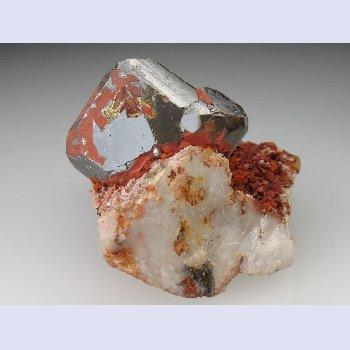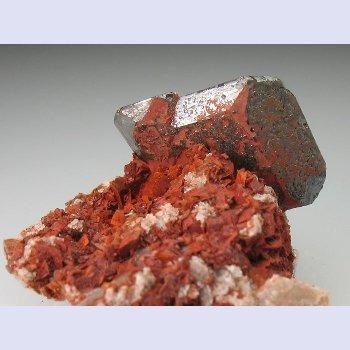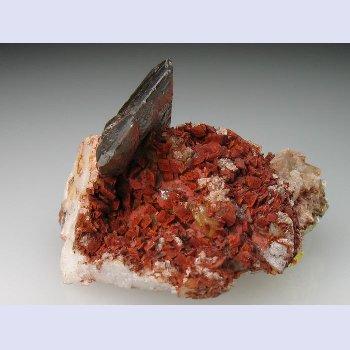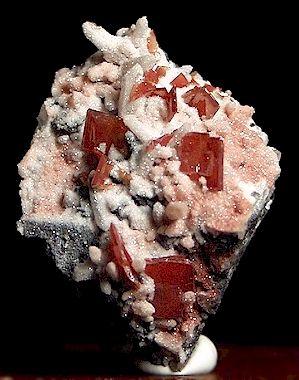| View previous topic :: View next topic |
| Author |
Message |
Tracy

Joined: 15 Sep 2006
Posts: 551
Location: Toronto



|
 Posted: Dec 27, 2008 19:11 Post subject: Why is this wulfenite silver? Posted: Dec 27, 2008 19:11 Post subject: Why is this wulfenite silver? |
|
|
I just acquired an interesting wulfenite from Tsumeb. It is a nicely formed crystal (two crystals, actually - I think there's a small one in one corner) on a red-coated calcite matrix, size is 2.6 x 2 x 1.5 cm and crystal size is about 1 cm. The crystal(s) is slightly covered by the red stuff too. It has the morphology of wulfenite but the metallic silver shine of hematite or galena. As I understand it, Tsumeb wulfenites tend to be colorless, so where does the silver color come from, (e.g. is it completely included with hematite)? Has anyone seen crystals like this before? It can be traced back to the '70's, based on the labels.
- Tracy
| Description: |
|
| Viewed: |
44648 Time(s) |

|
| Description: |
|
| Viewed: |
44647 Time(s) |

|
| Description: |
|
| Viewed: |
44646 Time(s) |

|
_________________
"Wisdom begins in wonder" - Socrates |
|
| Back to top |
|
 |
alfredo
Site Admin

Joined: 30 Jan 2008
Posts: 1018



|
 Posted: Dec 27, 2008 20:31 Post subject: Re: Why is this wulfenite silver? Posted: Dec 27, 2008 20:31 Post subject: Re: Why is this wulfenite silver? |
|
|
Whatever it is, it's a beautiful and fascinating specimen!
A pseudomorph of something else after wulfenite? I once saw "black wulfenites" from Arizona, which were really manganese oxide pseudomorphs.
Are there any damaged edges, so you could tell whether it's homogenous or just a surface film? (Reminds me that I once heard the late Dr. Fred Pough lamenting the modern trend to collect only perfect undamaged crystals; He said that a slightly damaged crystal was much more educational - You could study more of its properties, like cleavage.)
|
|
| Back to top |
|
 |
GneissWare

Joined: 07 Mar 2008
Posts: 1287
Location: California



|
 Posted: Dec 27, 2008 21:30 Post subject: Re: Why is this wulfenite silver? Posted: Dec 27, 2008 21:30 Post subject: Re: Why is this wulfenite silver? |
|
|
Hi Tracy,
It's a very aesthetic specimen.
Tsumeb produced several colors of wulfenite, including a clear, cream colored, yellow and red. Some wulfenite crystals can have an almost metallic luster -- I've seen it on Red Cloud pieces, for example. Its really hard to tell from the photos if this is simply luster, or possibly a replacement. But, its unlikely that wulfenite would be replaced by a metallic mineral (e.g., a sulfide). But stranger things have happened.
Attached is a photo of a red Tsumeb piece, so you know other colors exist.
Bob
| Description: |
Wulfenite from Tsumeb
4.5 X 3.5 cm |
|
| Viewed: |
44607 Time(s) |

|
|
|
| Back to top |
|
 |
Claus

Joined: 21 Dec 2008
Posts: 15
Location: Aarhus


|
 Posted: Dec 28, 2008 05:12 Post subject: Re: Why is this wulfenite silver? Posted: Dec 28, 2008 05:12 Post subject: Re: Why is this wulfenite silver? |
|
|
Tracy,
Tsumeb has produced Wulfenite of many different colours. I do not recall seeing black/silver but it may be included.
Long time ago (app. 1980) I saw lustrous, pitch-black Mimetite crystals from Tsumeb. They were supposedly from a single pocket and coloured by Goethite inclusions. Not sure I believe the Goethite postulate today, but it could be Mottramite. I suspect something similar happened to your Wulfenite.
All the best
Claus
_________________
Claus Hedegaard
Aarhus, Denmark |
|
| Back to top |
|
 |
John S. White
Site Admin

Joined: 04 Sep 2006
Posts: 1298
Location: Stewartstown, Pennsylvania, USA



|
 Posted: Dec 28, 2008 06:10 Post subject: Re: Why is this wulfenite silver? Posted: Dec 28, 2008 06:10 Post subject: Re: Why is this wulfenite silver? |
|
|
Gray-colored wulfenite from Tsumeb is well-recognized, and I suspect that what you have here is simply that with a very high luster. Replacement by a metallic mineral, I feel, is about as unlikely as any scenario that anyone can propose.
_________________
John S. White
aka Rondinaire |
|
| Back to top |
|
 |
Peter Megaw
Site Admin

Joined: 13 Jan 2007
Posts: 975
Location: Tucson, Arizona



|
 Posted: Dec 28, 2008 11:05 Post subject: Re: Why is this wulfenite silver? Posted: Dec 28, 2008 11:05 Post subject: Re: Why is this wulfenite silver? |
|
|
Richard V. Gaines studied grey (T) and bluish (SE) metallic wulfenite from both Tsumeb and the San Antonio Mine at Santa Eulalia, Chihuahua (whence my involvement). He had them probed somewhere and found the Santa Eulalia material (strongly dypiramidal elongate if that matters) contains over 1% tin and I am 85% sure he told me the Tsumeb material studied had high titanium . The Santa Eulalia specimens (3 total known) came from a distinctive localized tin-rich orebody called the "Cock's Orebody", so the tin content is geologically reasonable for that material. I am not sure where titanium would come from for Tsumeb material, perhaps from ilmenite gains in the pseudoaplite?
Anyone know who might have done this work for Richard?
|
|
| Back to top |
|
 |
Tracy

Joined: 15 Sep 2006
Posts: 551
Location: Toronto



|
 Posted: Dec 28, 2008 14:28 Post subject: Re: Why is this wulfenite silver? Posted: Dec 28, 2008 14:28 Post subject: Re: Why is this wulfenite silver? |
|
|
OK, so my "hematite-included" hypothesis lies in the realm of the absurd - I had to take a guess, however farfetched, just in case it wasn't totally nutso. I give myself brownie points for trying. :-)
I pulled out my loupe and searched for any broken surfaces. Wherever the crystal isn't silver (and it's a pretty shiny silver), it's red, with one exception being the interface between red and silver (see photo #1) where there is a gold-amber color that also shines in the light. Assuming there's some sort of layering event happening, I'm guessing that the silver is coating the red. In places it has the appearance of layers of paint. However, it's almost as though the red is a coating too, because it has a rough, matte-like texture. This would be MUCH easier to describe if I had a macro lens, and sadly I don't, so some non-technical words will have to do until I buy a better camera...
I forgot to mention that the photos above are published with permission from Crystal Classics, and that the specimen comes from the Uli Bahmann collection.
Once more I step out over the abyss - if the silver is a coating, could it be hematite (and the red coating the calcite and "underneath" the silver coating on the crystal a thinner layer of iron oxides)? Or titanium? I think it's pretty cool, regardless. Thanks all for the comments and input.
- Tracy
_________________
"Wisdom begins in wonder" - Socrates |
|
| Back to top |
|
 |
GneissWare

Joined: 07 Mar 2008
Posts: 1287
Location: California



|
 Posted: Dec 28, 2008 15:57 Post subject: Re: Why is this wulfenite silver? Posted: Dec 28, 2008 15:57 Post subject: Re: Why is this wulfenite silver? |
|
|
Hi Tracy,
It seems to be partially coated with hematite, as you surmised. Other than that observation, without actually seeing it, it is difficult to offer other opinions.
Bob
|
|
| Back to top |
|
 |
Tracy

Joined: 15 Sep 2006
Posts: 551
Location: Toronto



|
 Posted: Dec 28, 2008 18:09 Post subject: Re: Why is this wulfenite silver? Posted: Dec 28, 2008 18:09 Post subject: Re: Why is this wulfenite silver? |
|
|
Thanks Bob!
- Tracy
_________________
"Wisdom begins in wonder" - Socrates |
|
| Back to top |
|
 |
alfredo
Site Admin

Joined: 30 Jan 2008
Posts: 1018



|
 Posted: Dec 28, 2008 20:49 Post subject: Re: Why is this wulfenite silver? Posted: Dec 28, 2008 20:49 Post subject: Re: Why is this wulfenite silver? |
|
|
| Peter, Any ideas where the Sn came from in the Santa Eulalia wulfenites? In Bolivia, secondary Sn minerals are normally derived by decomposition of stannite or franckeite, since cassiterite of course doesn't normally decompose to form secondary minerals. But I don't see stannite or Sn-sulphosalts on the Santa Eulalia species list (at least not on Mindat, which is probably incomplete).
|
|
| Back to top |
|
 |
Peter Megaw
Site Admin

Joined: 13 Jan 2007
Posts: 975
Location: Tucson, Arizona



|
 Posted: Dec 28, 2008 23:41 Post subject: Re: Why is this wulfenite silver? Posted: Dec 28, 2008 23:41 Post subject: Re: Why is this wulfenite silver? |
|
|
Alfredo, neither franckeite nor stannite have been described from SE, but this orebody was so deeply oxidized that only things like cassiterite have survived. Stannite etc. may well have been present once upon a time. The body has tourmaline and topaz in the gangue and it looks like a highly volatile rich intrusive breccia dike that was thoroughly oxidized. This cuts skarn with odd composition...high V reported from the "actinolite" in the area (retrograded and probably supergene enriched hedenbergite skarn) and vanadinite is common and was co-produced from the orebody. There is not much left there either...area was aggressively exploited in the 40's and only the occasional crazy collector or geologist wanders through the area these days. Principal production moved 8-10 levels deeper over 40 years ago...and the company does very little assaying beyond the major ore and toxic metals.
_________________
Siempre Adelante! |
|
| Back to top |
|
 |
alfredo
Site Admin

Joined: 30 Jan 2008
Posts: 1018



|
 Posted: Dec 29, 2008 06:31 Post subject: Re: Why is this wulfenite silver? Posted: Dec 29, 2008 06:31 Post subject: Re: Why is this wulfenite silver? |
|
|
| Thanks, Peter. Sounds like the primary ore could have been really interesting. Hope they find some some day, hidden away deep.
|
|
| Back to top |
|
 |
Peter Megaw
Site Admin

Joined: 13 Jan 2007
Posts: 975
Location: Tucson, Arizona



|
 Posted: Dec 29, 2008 09:58 Post subject: Re: Why is this wulfenite silver? Posted: Dec 29, 2008 09:58 Post subject: Re: Why is this wulfenite silver? |
|
|
I agree...but so far the best we've come up with is quartz crystals studded with micro cassiterite prisms. Ore carries to 1% Sn locally even to depth.
_________________
Siempre Adelante! |
|
| Back to top |
|
 |
Tracy

Joined: 15 Sep 2006
Posts: 551
Location: Toronto



|
 Posted: Dec 31, 2008 10:24 Post subject: Re: Why is this wulfenite silver? Posted: Dec 31, 2008 10:24 Post subject: Re: Why is this wulfenite silver? |
|
|
Back to my crystal, I'm just wondering - I've seen calcite crystals from Tsumeb that were heavily included by hematite. I've also seen wulfenites from other localities described as "included." Why is it improbable that this wulfenite might be included - NOT replaced - by hematite - with the silver coating being a secondary consequence?
_________________
"Wisdom begins in wonder" - Socrates |
|
| Back to top |
|
 |
alfredo
Site Admin

Joined: 30 Jan 2008
Posts: 1018



|
 Posted: Dec 31, 2008 10:50 Post subject: Re: Why is this wulfenite silver? Posted: Dec 31, 2008 10:50 Post subject: Re: Why is this wulfenite silver? |
|
|
Forgive me if I missed it, but I think we still don't have an answer to the question of whether this is the actual color of the wulfenite (inside too), or just a surface film of another substance? If the surface looks homogenous under the microscope, then I wouldn't expect the colour to be due to hematite inclusions which, when extremely fine grained, would look more reddish.
I could imagine a very thin surface film of a metallic manganese oxide, perhaps? You could check that by dipping the specmen into weak H2O2 --- Mn oxides catalyze its decomposition and you'll see intense effervescence.
Wulfenite itself is subject to chemical reactions on its surface that might change the surface luster. If anyone wants to do an amusing experiment: Take a cheap disposable light yellow wulfenite crystal; dip an iron nail into HCl and rub the wet nail around on the wulfenite faces; they will turn blue. Now if anyone tries to sell you a blue wulfenite....
|
|
| Back to top |
|
 |
|




